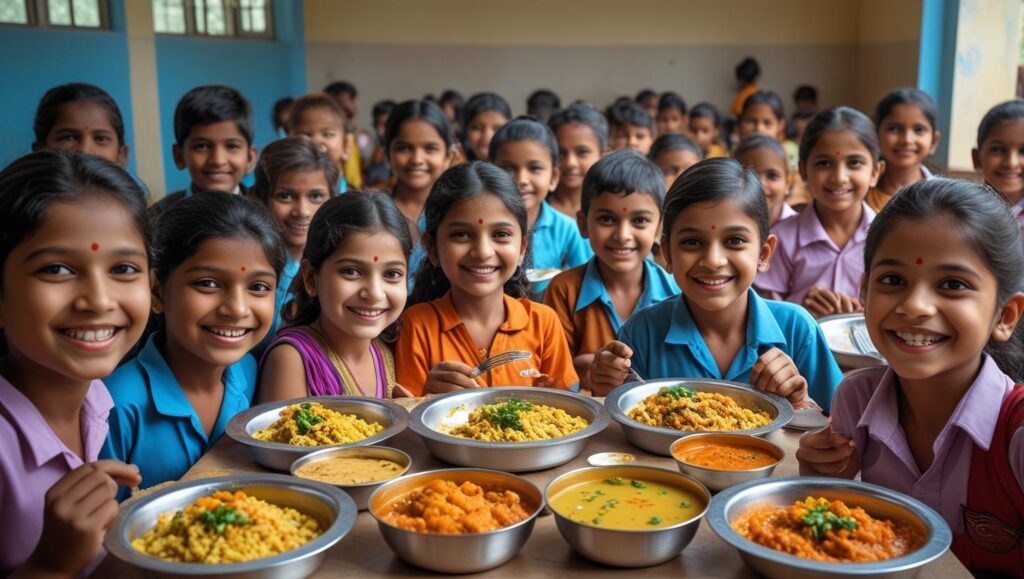
Meta Title: PM POSHAN (Mid-Day Meal) Scheme 2025: Benefits, Updates & Impact
Meta Description: Explore the PM POSHAN (Mid-Day Meal) Scheme 2025, India’s largest school nutrition program. Learn about benefits, updates, challenges, and its impact on children’s education.
Introduction: Why Nutrition in Schools Matters
In India, hunger and malnutrition remain two of the biggest barriers to learning. For millions of children, attending school does not just mean gaining knowledge—it also means receiving a reliable, nutritious meal through the PM POSHAN Mid-Day Meal Scheme 2025.
This program, formerly known as the Mid-Day Meal Scheme, ensures that children are not forced to choose between education and food. By addressing classroom hunger, the scheme improves attendance, retention, and overall learning outcomes.
The 2025 updates to PM POSHAN highlight the government’s commitment to nutrition, education, and social welfare, making it the largest school feeding program in the world.
What is PM POSHAN (Mid-Day Meal) Scheme?
The PM POSHAN (Pradhan Mantri Poshan Shakti Nirman) scheme was launched in 2021, revamping the traditional Mid-Day Meal program. Its primary aim is to provide one hot, cooked meal daily to children studying from Class 1 to Class 8 in government and government-aided schools.
Core Features of the Scheme:
- Covers over 11.8 crore students across India.
- Meals are designed to be nutritionally balanced, including cereals, pulses, vegetables, and proteins.
- Special focus on fortified rice and millets to address malnutrition and anemia.
- Technology-driven monitoring systems introduced for better transparency.
- Encourages community participation and sourcing ingredients from local farmers.
Objectives of PM POSHAN
The scheme is not just about filling stomachs—it is about building a healthier, more educated generation.
- Fight Malnutrition: Ensure every child receives at least one nutritious meal daily.
- Boost Enrollment: Attract children to schools, especially in rural and economically weaker regions.
- Reduce Dropouts: Encourage students to stay in school instead of working for food.
- Enhance Learning Outcomes: Proper nutrition keeps children attentive and improves academic performance.
- Promote Social Equity: Children from all backgrounds eat together, reducing caste and class barriers.
- Support Local Farmers: By sourcing grains, vegetables, and pulses locally, the scheme boosts rural income.
PM POSHAN 2025 Updates: What’s New This Year?
The scheme has evolved significantly in 2025, with several new policies designed to improve efficiency and nutritional quality.
- Inclusion of Millets: Following India’s push for millets during the International Year of Millets, meals now include ragi, bajra, and jowar for higher nutrition.
- Fortified Rice: To combat anemia, fortified rice is being supplied across most states.
- Pre-Primary Coverage: Some states have expanded the scheme to cover pre-primary students.
- Digital Monitoring: Mobile apps and biometric attendance are being used to ensure meal distribution is transparent.
- Gender Empowerment: The scheme continues to employ women as cooks, providing employment opportunities to rural households.
Impact of PM POSHAN on Children and Society
Educational Impact
- Increased Enrollment: Many parents, particularly in rural areas, send their children to school to ensure they receive free meals.
- Reduced Dropouts: Regular meals encourage children to continue their education.
- Better Learning: Studies show children who eat mid-day meals perform better academically.
Health & Nutrition Impact
- Noticeable reduction in child malnutrition and underweight cases.
- Fortified rice helps in reducing iron-deficiency anemia.
- Introduction of protein-rich foods has improved energy levels in children.
Social Impact
- Encourages social equality, as children of different backgrounds eat together.
- Boosts the local economy by sourcing food from local farmers.
- Provides employment to women, especially in rural areas as cooks and helpers.
Challenges in Implementation
Despite its success, PM POSHAN still faces challenges:
- Quality of Food: Instances of poor food quality have been reported in some areas.
- Infrastructure Gaps: Many schools lack proper kitchens and storage facilities.
- Irregular Funding: Delays in fund disbursement sometimes affect food supply.
- Monitoring Issues: In remote areas, ensuring transparency remains difficult.
- Cultural Differences: Meal preferences vary across states, requiring customization.
Way Forward: Strengthening PM POSHAN
Experts suggest several measures to strengthen the scheme:
- Increase budget allocation for better quality meals.
- Regular third-party audits to ensure food safety and nutritional standards.
- Use of solar-powered kitchens in rural areas.
- More focus on nutrition education, teaching children about healthy eating.
- Encourage CSR participation from private companies to support infrastructure.
Comparison Table: Old Mid-Day Meal vs. PM POSHAN
| Feature | Mid-Day Meal Scheme | PM POSHAN 2025 |
|---|---|---|
| Name | Mid-Day Meal | PM Poshan Shakti Nirman |
| Coverage | Class 1–8 | Class 1–8 (Pre-primary in some states) |
| Focus | Providing food | Nutrition, transparency, innovation |
| Nutrition | Basic meals | Fortified rice, millets, protein-rich foods |
| Monitoring | Manual records | Digital apps, biometric tracking |
| Employment | Local cooks | Women empowerment focus |
The PM POSHAN (Mid-Day Meal) scheme, launched by the Ministry of Education, Government of India, is one of the world’s largest school meal programs aimed at ensuring that no child in government schools studies on an empty stomach. The initiative, aligned with India’s National Nutrition Mission, provides free hot meals to millions of children daily, improving not just nutrition but also classroom attendance and retention.
FAQ Section (Schema-Ready)
Q1. What is the PM POSHAN Scheme?
The PM POSHAN scheme, launched in 2021, is India’s flagship school meal program that provides free, nutritious lunches to children in government and government-aided schools.
Q2. How many students benefit from PM POSHAN 2025?
Currently, over 11.8 crore children benefit daily, making it the largest school feeding program in the world.
Q3. What is new in PM POSHAN 2025?
In 2025, fortified rice, millets, pre-primary student inclusion, and digital monitoring have been added.
Q4. How does PM POSHAN improve education?
By reducing hunger, the scheme increases enrollment, reduces dropouts, and improves student concentration and learning.
Q5. Does PM POSHAN support farmers?
Yes, ingredients are locally sourced, giving farmers direct market access and boosting rural economies.
Q6. What are the challenges in PM POSHAN?
Challenges include food quality issues, infrastructure gaps, and delays in fund allocation.
Conclusion
The PM POSHAN (Mid-Day Meal) Scheme 2025 is more than just a nutrition program—it is a nation-building initiative. By addressing child hunger, promoting education, and empowering rural communities, it continues to play a crucial role in India’s development journey.
As India advances into 2025, strengthening PM POSHAN through innovation, transparency, and inclusivity will ensure that every child not only gets an education but also the nutrition needed to succeed.

